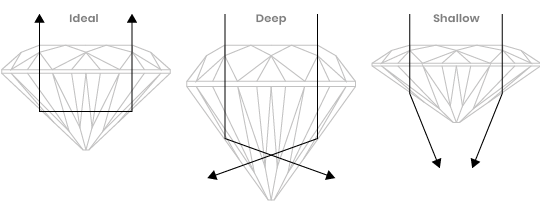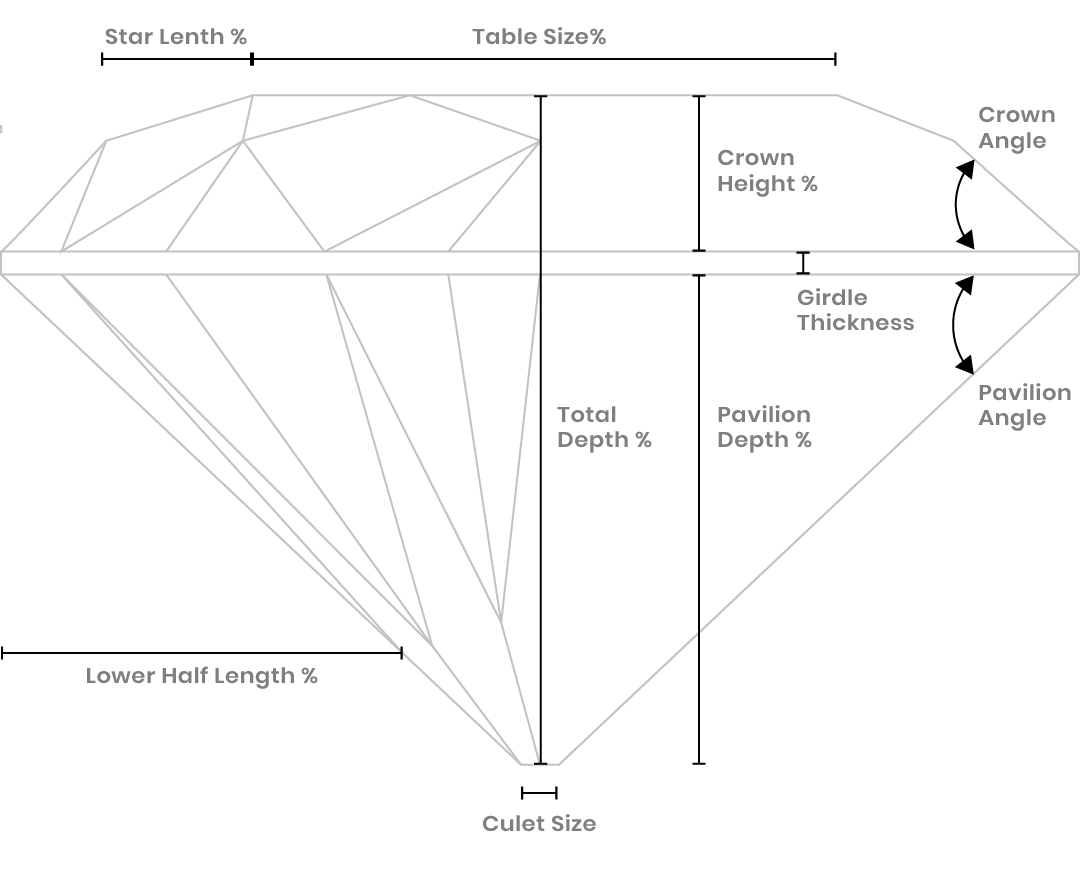Diamond Education
The 4 C'sDiamond Anatomy & Cut Quality
Table
The table is the largest facet on a diamond. Most of the light enters the stone and bounces back to the viewer through this facet. It should be fairly large, otherwise the diamond will look small and boring. If it’s too large, however, the diamond will have no fire due to the smaller crown main facets.
A diamond should have a table size roughly between 52-62% of the diamond width, also known as the average girdle diameter. Within this range, table size is mostly a matter of personal taste, a trade-off between brilliance and fire.
.


Crown
The ring of facets around the table, the crown affects how much dispersion or fire the diamond shows. Size as well as the angle of the crown facets matter here. Cut the crown angle shallow and the diamond will have excellent brilliance but no fire. Cut the crown angle steep and the diamond will have excellent fire but no brilliance.
Steep crown angles also hide a lot of weight without making the diamond appear any bigger.
Cutters will often choose a steep or shallow crown angle depending on whether they’re working with longer or wider rough.
Ideally, the crown angle should be between 31.5-36.5°. As with table size and crown facet size, the crown angle is a trade-off between brilliance and fire. In order for the stone to have excellent symmetry, it must have the same crown angles all around. If the facets have differing crown angles, the table will appear slanted. The crown height percentage, the proportion of the crown in comparison to the total depth of the diamond, should be 12.5-17%.
.
Understanding the 4 C’s of Diamonds Shopping
A diamond’s quality is determined by the 4C’s:
- Cut: Quality of the angles, proportions, facets, and finishing details.
- Color: How colorless the diamond is.
- Clarity: How clean the diamond is of inclusions and blemishes.
- Carat: The weight of the diamond.
Cut
The ‘Cut’ is perhaps the most important aspect of a diamond quality that impacts a diamond’s beauty. Diamond Cut specifically refers to the quality of a diamond’s angles, proportions, symmetrical facets, brilliance, fire, scintillation and finishing details. These factors directly impact a diamond’s ability to sparkle, along with its overall aesthetic appeal..


Color
Diamond Color is graded in terms of how white or colorless a diamond is. The GIA grades diamonds from D to Z, with D being the most colorless, and Z containing noticeable brown or yellow tint. The diamond color chart below shows how each grade looks next to each other.


Clarity
A Diamond’s Clarity grade evaluates how clean a diamond is from both inclusions and blemishes. Clarity is graded by the GIA on the following diamond clarity chart:
- FL (Flawless)
- IF (Internally Flawless)
- VVS1 (Very, Very Slightly Included 1)
- VVS2 (Very, Very Slightly Included 2)
- VS1 (Very Slightly Included 1)
- VS2 (Very Slightly Included 2)
- SI1 (Slightly Included 1)
- SI2 (Slightly Included 2)
- I1 (Inclusions 1)
- I2 (Inclusions 2)


Carat (Size)
The term ‘carat’ (commonly abbreviated to just ‘ct’) refers to the weight of a diamond, although it is often (incorrectly) used to describe the size of a diamond. The definition of a carat has changed over time, but since 1913 the international standard has been 200 milligrams, or one-fifth of a gram.

